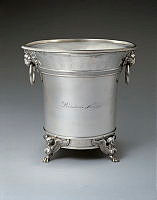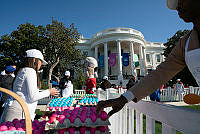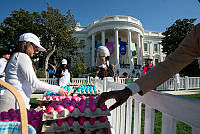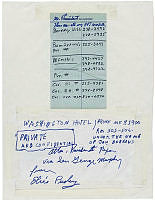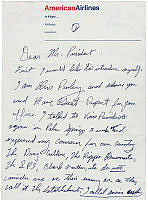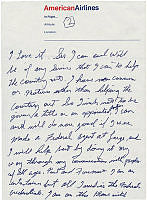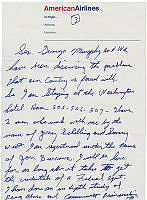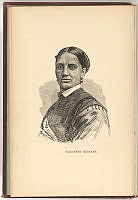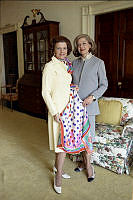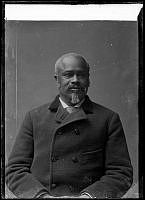Under This Roof
The Art of Working on the White House Staff
Copyright © Fall 2009 White House Historical Association. All rights reserved under international copyright conventions. No part of this article may be reproduced or utilized in any form or by any means, electronic or mechanical, including photocopying, recording, or by any information storage and retrieval system, without permission in writing from the publisher. Requests for reprint permissions should be addressed to books@whha.org
When you join the White House staff, you enter a unique community full of surprising paradoxes. The men and women on the staff are loyal to their president and supportive of his or her policies but are also characterized by such a diversity of experience and life outlook that they are nonetheless pushed to travel in different policy directions. Some are barely in their 30s. Some are much older, with years of service behind them—careers in government, business, and academia. Most are civilians, but some are military with that special outlook that comes from having long and proudly worn a uniform. They come from every corner of America and from each of the several “wings” of the ruling political party. Your relationships will be full of pressures, tension, frustrations, and excitement. Life in the White House is like being immersed in a magnetohydrodynamic plasma.
Many of your staff colleagues will have come straight from a hard-fought campaign where “winning” means zipping out a rapid, aggressive response to any criticism and rendering the critics powerless, while others realize that “governing” means taking in all points of view and working out actionable compromises to achieve long-term progress. You will be governing.

Chief of Staff Rahm Emanuel reviews a newspaper in the Oval Office while President Barack Obama talks on the phone in 2009.
White House photo by Pete SouzaYour view of the White House staff from the outside probably is that it is made up of broad-gauged generalists with flexible assignments. After you arrive you will be surprised to find that the staff is in fact organized into definitive specialties: national security, legislative liaison, presidential personnel, legal affairs, scheduling, and so on. (Some of the specialists also have towering egos.) The boundary lines separating those specialized jurisdictions are so firm that it is regarded as a serious infraction when members of one specialty take actions that trespass upon the responsibilities of another. For example, no staffer goes up to Capitol Hill to make deals with senators or congressmen without the imprimatur of the assistant to the president for legislative affairs. No one at the White House—but no one!— presents legal advice to the president without going through the counsel to the president.
And yet, the planning and the execution of a major presidential initiative require the complete collaboration of all of the specialties, an integration crossing all the jurisdictional boundaries. How, you will wonder, can such integration be accomplished? How are these specialized egotists going to be—to use Steve Hadley’s words—“knitted up” into a team that operates, as H. R. “Bob” Haldeman specified, “with zero defects”?1
The high priest of integration, you will shortly learn, is not the president. “I don’t want to have to be my own sergeant-major,” President Dwight Eisenhower declared.2 The integrator-in-charge is the White House chief of staff, plus the two deputy chiefs of staff who are assistant high priests, the several of them backed up by the staff secretary. Every piece of paper destined for the president goes through the staff secretary’s office and thence enters a highly disciplined coordination process.

Working behind the scenes, many White House staffers are imbued with a “passion for anonymity,” and they are frequently unidentified in historic photographs. Here is a photo of an unidentified man at a desk in the West Wing waiting room in 1946.
Harry S. Truman LibraryYou may join a specialized policy office. You will then encounter some rules—not casually dreamed up by the current president but distilled from decades of White House experience:
Rule 1: Every presidential policy issue is to have a home—and only one home—in the White House. This means that a given policy issue will be managed and presented by one assistant to the president, who of course consults many colleagues but who stays in charge of, and responsible for, that issue, from start to finish.
Rule 2: It is recognized that each policy assistant has strong views of his or her own about the issue under consideration, but the assistant is never to present his or her own position to the president in a way that hampers or interferes with the presentation of the views of others—especially dissents—from the cabinet or the staff. Some White House officers in the past have not lived up to this challenge.
Rule 3 (vintage 1936): While you are proud of what you are doing—sitting there and creating history— you would not mind getting some public credit for it. But no; you do your work behind the scenes; you are to be imbued with a “passion for anonymity.”3 Only a very few senior staff members are brought forward to meet the public. If you are doing policy analysis, you will need full and accurate information; for most of that you will rely on the cabinet departments. You will soon learn who your trustworthy sources are, and you will be establishing networks of informal relationships. If, for example, you are in the White House counsel’s office, you will find that your boss is not only an adviser to the president but is the center of a circle of fellow counsels in many of the departments and agencies. Your boss will, in effect, have picked those departmental counsels and will be in constant contact with them, and, not surprisingly, they will respond to White House queries with alacrity. This “circle” metaphor is true of several of the senior presidential assistants, including the head of legislative affairs, the head of communications, and the director of the presidential personnel office.

Two unidentified women at work in the White House during the Eisenhower administration.
Dwight D. Eisenhower Presidential LibraryRule 4 (vintage 1939, from the president’s original executive order establishing the White House staff): “In no event shall [members of the White House staff] be interposed between the President and the head of any department or agency.”4 That it is difficult to hew to this rule is evidenced by a real incident from the Nixon administration. On November 20, 1969, a group of Native American activists seized and occupied Alcatraz Island. The country—in fact the world—took sympathetic interest. But Alcatraz was federal property, and even if it was surplus federal property, the seizure was lawbreaking. Special counsel to the President Leonard Garment asked, “Who has Alcatraz?” Answer: the General Services Administration, which has custody of surplus federal property. Its administrator was Robert Kunzig. Garment telephoned Kunzig to ask about next steps. “Simple” said Kunzig, “we will have U.S. marshals there in the morning and force the Indians off the island.” Garment countermanded the administrator. “You’ll do nothing of the sort. We are going to send a vice presidential staffer out to meet and talk with the Indians; call off your marshals!” Kunzig angrily acquiesced, but said, “I’ll never talk to you again!”5 By that 1939 standard, this looked like “interposition,” but since Kunzig decided he would not appeal to the president, who would have backed Garment, the order stood, and what could have been a bloody confrontation was avoided. (The negotiations took eighteen months before the last of the Native American occupiers were peacefully removed.) This incident illustrates the role you and other White House officers will play, particularly in a crisis period, the 1939 precept notwithstanding.

President Ford with his chief of staff, Dick Cheney, in 1976.
Library of CongressAs you do your work, you may need to be wary of what you write down and be especially hesitant about sending written material out of the White House. If you meet with the president, there may be no written record of his decisions, as anything set down in ink or in a computer’s memory can be subpoenaed by an investigating congressional subcommittee. The author says this with reluctance; he was the deputy cabinet secretary for President Eisenhower, and his office regularly sent cabinet papers, agendas, and the presidential records of action around to all cabinet members. Full records were kept; there were no leaks and no subpoenas. But those were “the good old days.”
Spending more time at the White House, you will uncover another surprise: the size of the White House community into which you have entered. Your original untutored impression was that the White House staff is an intimate group—a few dozen senior advisers supported by a few score of assistants. The author and his wife recall the Christmastime minireception one year in the president’s personal quarters upstairs in the residence. President and Mrs. Eisenhower and a score of staffers relaxed while a sextet of colleagues played carols with handheld bells. In that gemütlich setting, “White House staff” seemed like a very small universe.

A small Christmas party for Eisenhower staffers.
Dwight D. Eisenhower Presidential LibraryBut it is not. The White House establishment today is made up of 74 principal policy offices in which 459 men and women work (for instance, the deputy national security adviser for international economics).6 There are 21 supporting policy offices with 213 staffers (for example, the director of advance for the president’s spouse). By far the largest elements of the White House staff are the 40 technical and professional units—more than 5,900 employees—who make presidential operations possible and who provide the president with the necessary protection (for instance, the White House Communications Agency, which handles all the president’s encrypted communications traffic, or the manager of Camp David, the crew of Marine One, the presidential helicopter, or the presidential protective units of the U.S. Secret Service). These latter professional offices are not distant adjuncts but are key parts of a whole White House staff family. Everything the president or the senior staff would like to do involves them; reciprocally, every one of their requirements affects the activities of the president and of the whole staff. There is—there has to be—total integration throughout the White House establishment of those 135 offices and those 6,574 men and women. And Haldeman was right about “zero defects.” A deficiency anywhere in that whole system risks unbelievable damage.
The size of the White House staff has grown steadily over the years as it has followed—and matched—the growth of presidential responsibilities. A statute in 1946 made the president responsible for “full employment”—in effect responsible for the health of the U.S. economy. Another 1946 statute expanded the nation’s wartime experience into leadership in foreign information and cultural programs. A statute in 1947 put the president clearly and formally in the role of coordinator and manager of the conduct of national security affairs. The Soviet’s Sputnik satellite accelerated development of a space program. The attacks on September 11, 2001, thrust the United States into a war on terror and challenged the president to make his case to the American public, and the world, by expanding the White House communications function. Each new presidential responsibility resulted in new White House machinery; step by step the White House expanded in numbers of offices and in totals of staff. Unchanged, however, has been the principle that executive authority is vested in one person: the president is in charge. The White House—each new president—thus has a management challenge to balance the plurality of offices and staff with the singularity of one chief executive, and to preserve collegiality in a hierarchical system. You will experience some of the pangs of that duality.

Although the White House staff has grown large enough today to occupy much of the Eisenhower Executive Office Building, small groups within the staff still gather in the White House to celebrate special events, holidays, and homecomings. In this photograph, President Franklin D. Roosevelt celebrates his birthday with staff.
Library of CongressThe other growth has been in structure. The Office of Chief of Staff, unknown in the past, established by Eisenhower (and disdained by President John F. Kennedy) has now become indispensable. Today’s White House organization is a continuation of the Eisenhower model, but characterized by important innovations that keep the White House responsive to the changing demands laid on the executive branch.
Even though you are enmeshed in the present, you become more and more aware that you are also surrounded by the past. While the White House is a working office, it is also a museum. Its architecture and its furnishings are from its storied past. Do not miss reading President John Adams’s prayer on the mantelpiece in the State Dining Room, inscribed at the request of President Franklin D. Roosevelt. Adams’s words are from a letter to his wife Abigail, the day after he first moved into the White House, November 1, 1800:
I pray Heaven to bestow the best of Blessings on this House, and on all that shall hereafter inhabit it. May none but honest and wise men ever rule under this roof.7

Located to the west of the White House, the Eisenhower Executive Office Building houses the offices of much of the president’s staff. When completed in 1888 the mighty granite structure was the State, War and Navy Building. Executive staff began using rooms there in the early twentieth century and by the century’s end the building was named for President Eisenhower and given over entirely to executive offices.
Ronald Reagan Presidential Library & Museum/NARAAsk the chief usher to show you what hangs on his office wall: the piece of charred timber from the fire of 1814. Outdoors, look for the remnants of a carved stone trough used in President Andrew Jackson’s time to cool milk. Take advantage of the opportunity to walk through the second floor rooms on the west side of the 1880s Eisenhower Executive Office Building (the former Old Executive Office Building), which were the suite of the secretary of war in the 1890s. Twenty-one coats of paint have been peeled off, with exquisite care, to reveal beautiful ceiling murals of Mars, the god of war, and of Victoria, the goddess of victory, riding in their chariots.
And you will also be quickened by the future. Have a colleague show you the National Security Council’s new Situation Room, where the future of presidential diplomacy, of the governance of national security affairs, has arrived. In a conference room, opened in spring 2007, the president and his national security advisers can meet via top secret video-teleconference with the U.S. commanding general in Iraq and our ambassador in Baghdad. Recently President George W. Bush and the president of Iraq signed a memorandum of understanding about U.S. armed forces in Iraq, via video-teleconference. The same communications arrangements are in place with the prime minister of the United Kingdom and the chancellor of Germany, and they are being installed in other U.S. embassies. The conduct of presidential-level diplomacy has entered upon a breathtakingly new future.

President Barack Obama at a National Security Council meeting in the White House Situation Room in 2009.
White House photo by Pete SouzaWelcome to the art of being a member of the White House staff! Your eighteen-hour days will be full of a grand mixture of tension, frustration, and accomplishment. When your service there is ended, you will participate for years afterward in an alumni group of the administration in which you served. And much later you will proudly tell your grandchildren about those times when you had your hand on the doorknob of history, under this roof.







